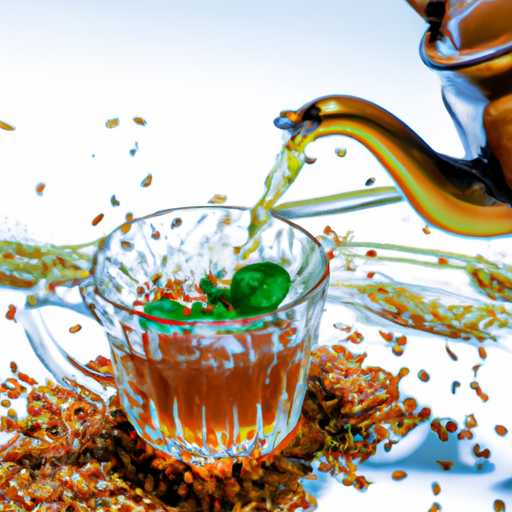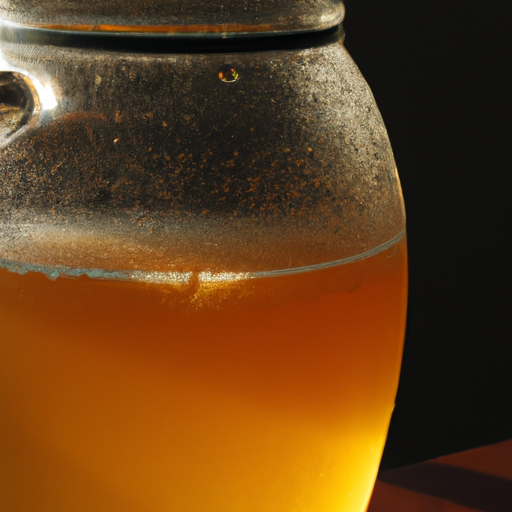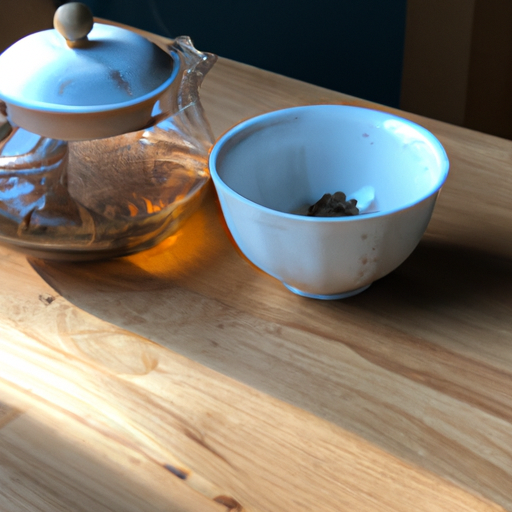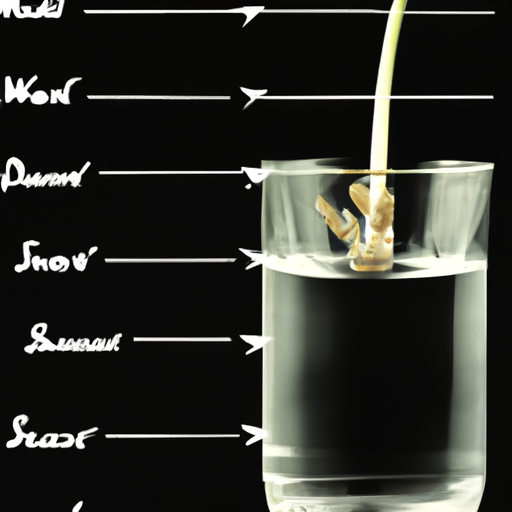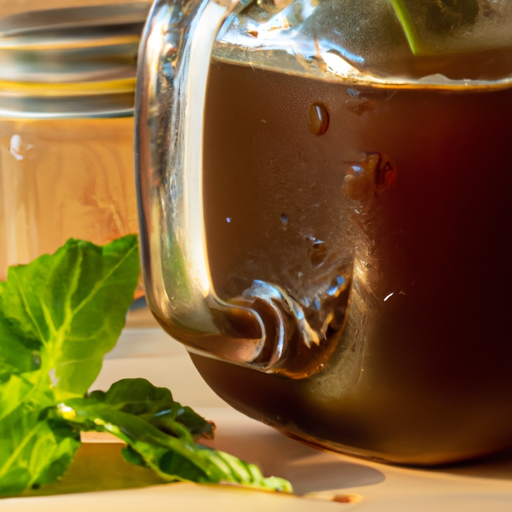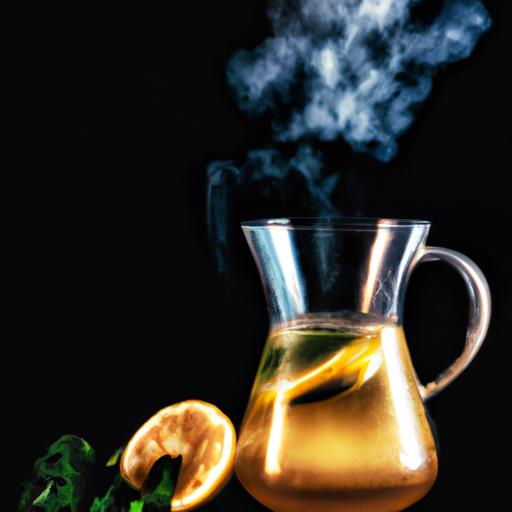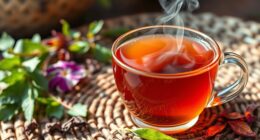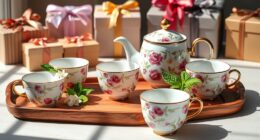I recently stumbled upon the delightful and nutritious beverage known as Korean barley tea, and I’ve become completely hooked! For those in search of a caffeine-free option other than coffee or tea, or just a delicious method to keep hydrated, Korean barley tea is an excellent selection.
And the best part? It’s super easy to make at home! In this article, I’ll walk you through the steps of making your own Korean barley tea, from toasting the barley to straining and serving. I’ll also share some health benefits of this tasty beverage, and some variations you can try.
So grab your mug and let’s get started!
Key Takeaways
- To enhance the nutty flavor of Korean barley tea, it is recommended to toast the barley before preparing the tea.
- Korean barley tea can be prepared using different types of barley, and the steeping time can be adjusted to achieve different flavors.
- Adding honey, sugar, lemon, orange, mint, or ginger to Korean barley tea can enhance its taste and provide additional health benefits.
- Korean barley tea can be stored in the fridge in an airtight container and reheated gently over low to medium heat to preserve its natural sweetness and nutty flavor. Frozen barley tea cubes can also be reheated for a refreshing drink.
Gather Your Ingredients
Gathering your ingredients is crucial in making delicious Korean barley tea, so make sure you’ve got everything you need before you start! First, you’ll need to choose your preferred barley type. Some popular options include roasted barley, unhulled barley, and barley tea powder. You can find these ingredients at most Asian groceries or online.
Aside from the barley, you’ll need a pot, a tea strainer, and water. When it comes to brewing equipment, there are a few options. The most traditional method is to use a Korean earthenware pot called a ttukbaegi. These pots are great for retaining heat and enhancing the tea’s flavor. However, if you don’t have a ttukbaegi, a regular pot will do just fine. Additionally, you can use a tea infuser ball or a cheesecloth to strain the tea if you don’t have a strainer.
Once you’ve gathered your ingredients and brewing equipment, it’s time to rinse and toast the barley. This step will help remove any impurities and enhance the tea’s nutty flavor. Rinse the barley under cold water and let it dry for a few minutes. Then, toast the barley in a dry pan over medium heat until it turns a light brown color and gives off a nutty aroma.
With your barley toasted and ready to go, you’re one step closer to enjoying a delicious cup of Korean barley tea.
Rinse and Toast the Barley
First, you’ll want to give those little grains a good bath in some cool water to wash away any dust or dirt that might have accumulated during their journey to your kitchen. This step is crucial in making sure your barley tea is clean and free from any unwanted particles. After rinsing, it’s time to toast the barley. Toasting not only enhances the flavor of the barley, but it also gives it a beautiful golden color. There are different toasting techniques that you can use depending on the type of barley you have.
In the table below, I’ve listed some popular barley types and their corresponding toasting techniques:
| Barley Type | Toasting Technique |
|---|---|
| Hulled Barley | Dry Toasting |
| Pearl Barley | Wet Toasting |
| Black Barley | Dry Toasting |
Dry toasting involves toasting the barley in a dry skillet without any oil or liquid. Wet toasting, on the other hand, involves toasting the barley in a skillet with a small amount of water. Different barley types require different toasting techniques, so make sure to do your research before starting.
Once you’ve mastered the toasting technique for your chosen barley type, it’s time to move on to the next step: boiling the water and adding the barley. This is where the magic starts to happen as the flavors and aromas of the barley infuse into the water.
Boil the Water and Add the Barley
Once you’ve rinsed and toasted the barley to perfection, it’s time to bring water to a boil and add in those beautifully golden grains. Before doing so, it’s important to consider the type of water you use. Using filtered water can enhance the taste of the tea by removing any impurities or chemicals that may be present in tap water. This helps to create a cleaner, crisper flavor that truly allows the barley to shine.
When it comes to the type of barley to use, there are many different options available. Some popular choices include roasted barley, hulled barley, and pearled barley. Each type of barley offers its own unique flavor profile and nutritional benefits. For example, roasted barley is known for its nutty, slightly sweet taste, while hulled barley is a great source of fiber and protein. Experimenting with different types of barley can help you find the perfect flavor and nutritional combination that works for you.
Once you’ve added the barley to the boiling water, let it simmer for about 10-15 minutes. This allows the grains to release their full flavor and aroma. After simmering, remove the pot from the heat and let the tea steep for an additional 5-10 minutes. This step is crucial as it allows the tea to fully infuse with the barley and develop its unique flavor.
With these simple steps, you can create a delicious and nutritious cup of Korean barley tea that’s sure to satisfy.
Let the Tea Steep
Now it’s time for you to let the tea steep and really soak up all of those delicious flavors, so sit back and relax while the magic happens. How you steep your Korean barley tea can greatly impact the overall taste and aroma, so it’s important to do it properly.
Here are a few tips to ensure your tea is steeped to perfection:
- Different steeping times for different flavors: Depending on your personal taste preference, you can adjust the steeping time to achieve a stronger or milder flavor. Generally, steeping for 5-10 minutes will result in a light, refreshing taste while steeping for 15-20 minutes will produce a richer, nuttier flavor.
- For a sweeter taste, add a few drops of honey or a pinch of sugar while steeping.
- To enhance the aroma, add a slice of lemon or orange to your tea while it steeps.
- For an added health benefit, consider adding a few sprigs of fresh mint or ginger to your tea.
Once you’ve let your tea steep for the desired amount of time, it’s time to strain and serve. The easiest way to strain your tea is by using a mesh strainer or cheesecloth. Simply pour the tea through the strainer, catching any loose barley or tea leaves, and into your serving cup.
If you prefer, you can also strain the tea directly into a pitcher and serve it over ice. The possibilities are endless when it comes to Korean barley tea, so feel free to experiment with different steeping times and flavor combinations until you find your perfect cup.
Strain and Serve
To enjoy a refreshing cup of this aromatic beverage, strain out any loose ingredients and serve it in your favorite cup or pitcher. Straining your barley tea is a crucial step before serving, as it helps remove any impurities or residue that might have accumulated during the brewing process.
There are different straining techniques that you can use, depending on your preference or the tools you have available. One common method is using a fine mesh strainer, which can effectively catch any solid particles while allowing the liquid to pass through. You can also use a cheesecloth or a coffee filter, which can further refine the texture of the tea. Make sure to press down gently on the solids to extract as much liquid as possible.
After straining, you can dispose of the solids or use them as a garnish or flavoring for other dishes. When it comes to serving your barley tea, there are various suggestions that can enhance your experience. You can serve it hot or cold, depending on the weather or your mood.
You can also add sweeteners, such as honey, sugar, or stevia, to balance out the natural bitterness of the tea. Some people like to add slices of lemon or ginger, which can provide a subtle zingy flavor and extra health benefits. Whatever your serving preference, make sure to savor each sip and appreciate the unique taste and aroma of Korean barley tea.
Now that you know how to strain and serve your barley tea, let’s talk about the health benefits of this beloved beverage.
Health Benefits of Korean Barley Tea
Sipping on a cup of this aromatic brew can work wonders for your overall health, from reducing inflammation to boosting digestion. Here are three health benefits of Korean barley tea that you should know:
-
Hydration: Korean barley tea is a great way to stay hydrated throughout the day. It contains no calories and can be enjoyed hot or cold, making it a refreshing and healthy beverage choice for any time of day.
-
Digestive health: Korean barley tea is known for its ability to improve digestion. It contains a high amount of fiber, which helps to regulate bowel movements and prevent constipation. Additionally, the antioxidants in barley tea can help to reduce inflammation in the digestive tract.
-
Weight management: Incorporating Korean barley tea into a healthy diet can aid in weight management. The fiber in barley tea can help to promote feelings of fullness and reduce overall calorie intake. Additionally, drinking barley tea instead of sugary drinks can help to reduce empty calorie consumption.
With these health benefits in mind, it’s easy to see why Korean barley tea is a popular beverage choice.
In the next section, we’ll explore the various ways to prepare and enjoy this delicious tea.
Variations of Korean Barley Tea
I love experimenting with different variations of Korean barley tea, and two of my favorites are adding citrus or ginger and cold brewing the tea.
Adding a slice of lemon or lime to the tea gives it a refreshing tang, while a chunk of ginger adds a spicy kick.
Cold brewing the tea is a great option for hot summer days. It creates a smooth, mellow flavor that’s perfect for sipping on ice.
Adding Citrus or Ginger
You can enhance the flavor of your Korean barley tea by adding a slice of fresh ginger or a wedge of citrus fruit. This simple addition can transform your tea into a refreshing and invigorating drink.
Here are some ideas for incorporating citrus or ginger into your Korean barley tea:
- Add a slice of lemon or lime to your tea for a zesty punch of flavor.
- Try adding a wedge of orange or grapefruit for a sweeter, more mellow taste.
- For a spicy kick, add a slice of fresh ginger to your tea. Ginger is also known to have health benefits, such as aiding digestion and reducing inflammation.
- Alternatively, you can use ginger powder or syrup to flavor your tea.
- Experiment with different combinations of citrus and ginger to find your perfect balance of flavors.
If you prefer a colder and more refreshing drink, you can try making cold brewed barley tea.
Cold Brewed Barley Tea
To create a refreshing summer drink, try cold brewing barley tea using only water and roasted grain. Barley tea recipes usually involve boiling water and letting the tea steep for a few minutes. However, cold brewing is a different method that involves soaking the tea in cold water for a longer period of time. The result is a smoother and milder flavor, perfect for those who find the traditional method too bitter.
Benefits of cold brewing barley tea are aplenty. Firstly, it’s a healthier option as it retains all the nutrients and antioxidants that are usually lost during preparation. Secondly, it’s a great way to beat the summer heat as the tea can be served cold over ice. Finally, it’s a convenient option as you can prepare a large batch in advance and store it in the refrigerator for later use. Here’s a table outlining the differences between traditional and cold brewing methods:
| Traditional Method | Cold Brewing Method |
|---|---|
| Water is boiled | Tea is soaked in cold water |
| Tea is steeped for a few minutes | Tea is steeped for several hours |
| Bitter taste | Smoother and milder taste |
| Served hot or cold | Served cold over ice |
Now that you know how to cold brew barley tea, let’s move on to tips for storing and reheating it.
Tips for Storing and Reheating Barley Tea
Keep your barley tea fresh and flavorful by storing it in an airtight container in the fridge, and simply reheating it whenever you want a comforting and delicious sip. Storing barley tea in the fridge will help preserve its natural sweetness and nutty flavor for a longer period.
Make sure to use a clean container with a tight-fitting lid to prevent the tea from absorbing any odors and flavors from other foods in the fridge.
When reheating barley tea, it’s important to avoid boiling it as this may cause the tea to become bitter. Instead, gently heat the tea over low to medium heat until it reaches the desired temperature. You can also reheat barley tea in a microwave-safe container by heating it in short intervals and stirring it in between until heated through.
If you don’t plan on drinking the barley tea within a few days, it’s best to freeze it. Pour the tea into an ice cube tray and freeze it overnight. Once frozen, transfer the barley tea cubes into a freezer bag and store them in the freezer. This way, you can easily pop a few cubes into a cup and heat them up whenever you want a refreshing and soothing drink.
Frequently Asked Questions
How long does Korean barley tea last in the refrigerator?
As the old saying goes, "waste not, want not."When it comes to storing barley tea, it’s important to keep in mind that it has a shelf life just like any other beverage.
If you’ve made a large batch and are wondering how long it will last in the refrigerator, the answer depends on a few factors. Generally speaking, barley tea can be stored in the refrigerator for up to a week. However, this can vary depending on how it was prepared, how well it was stored, and the temperature of your fridge.
To ensure your barley tea stays fresh for as long as possible, it’s best to store it in an airtight container and keep it at a consistent temperature. That way, you can enjoy the delicious and refreshing taste of barley tea for days to come.
Can you use roasted barley instead of toasted barley?
Yes, you can use roasted barley instead of toasted barley to make barley tea. However, it’s important to note that using roasted barley will result in a different flavor profile compared to using toasted barley.
Roasted barley has a more intense and nutty flavor, while toasted barley has a milder and sweeter taste. Depending on your preference, you can experiment with both types of barley to find the flavor that you enjoy the most.
It’s also worth mentioning that barley tea is a popular beverage in Korea and other parts of Asia, and it’s known for its health benefits, such as aiding digestion and reducing inflammation.
Can you add sweeteners like honey or sugar to Korean barley tea?
When it comes to sweetening Korean barley tea, there are several options. Honey and sugar are two popular choices, but the decision ultimately depends on personal preference.
Honey is a natural sweetener that has added health benefits, such as antioxidants and antibacterial properties. However, it can also overpower the delicate flavor of the barley tea.
On the other hand, sugar is a simple and straightforward sweetener that doesn’t affect the taste of the tea as much. It’s important to note that adding sweeteners to Korean barley tea can increase the calorie and sugar content, so it’s best to use them in moderation.
Overall, sweetened Korean barley tea can provide various health benefits, including improved digestion, hydration, and reduced inflammation.
How does drinking Korean barley tea benefit the body?
When it comes to health benefits, drinking Korean barley tea is a no-brainer. Not only does it offer a unique and refreshing flavor, but it’s also packed with nutritional value.
From aiding in digestion to reducing inflammation, this tea has a lot to offer. Plus, it’s a great source of antioxidants and can even help lower cholesterol levels.
As someone who prioritizes my health and wellness, I love incorporating Korean barley tea into my daily routine. It’s a simple and delicious way to give my body the nutrients it needs to function at its best.
After all, as they say, ‘an apple a day keeps the doctor away.’ And in my opinion, a cup of Korean barley tea does just the same.
Is it possible to make Korean barley tea without a strainer?
Yes, it’s possible to make Korean barley tea without a strainer using strainer alternatives. One popular method is to use a coffee filter or cheesecloth to strain the tea. Simply pour the brewed tea through the filter or cheesecloth and into a separate container to remove any barley grains or debris.
Another option is to use a French press, which can be used to steep the barley tea and then press down the plunger to filter out the grains.
Additionally, some people choose to simply let the barley grains settle to the bottom of the pot and carefully pour the tea into cups, avoiding the grains.
When brewing Korean barley tea without a strainer, it’s important to be mindful of any debris that may be present in the tea and to use appropriate brewing techniques to ensure a smooth and flavorful tea.
Conclusion
And there you have it, my friends! A simple and delicious recipe for Korean barley tea that you can enjoy anytime, anywhere.
Not only is it easy to make, but it also has numerous health benefits, making it a perfect addition to your daily routine.
But wait, there’s more! Did you know that you can also experiment with different variations of Korean barley tea? Try adding some honey or lemon for a sweeter taste, or even some ginger for an extra kick.
And don’t forget to store any leftover tea in the fridge for later, or simply reheat it to enjoy its warm and comforting taste once again.
So what are you waiting for? Go ahead and give this recipe a try, I promise you won’t be disappointed. And who knows, you may just discover a new favorite drink that you’ll want to enjoy every day. Cheers!

